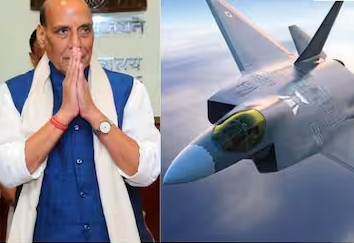
Follow WOWNEWS 24x7 on:

India’s defence ambitions just got a turbo boost. In a major announcement that signals a leap toward self-reliance in aerospace technology, Defence Minister Rajnath Singh revealed that India has officially taken steps to manufacture fifth-generation fighter aircraft and their engines domestically. The move, part of the country’s broader Aatmanirbhar Bharat vision, includes a strategic partnership with French aerospace giant Safran and fresh orders for indigenous Tejas jets worth ₹66,000 crore. This marks a defining moment in India’s journey to join the elite club of nations capable of producing advanced combat aircraft and propulsion systems.
Here’s a detailed breakdown of the announcement and its far-reaching implications.
1. Strategic leap: India-Safran collaboration
- India will co-develop and manufacture fifth-generation fighter jet engines in partnership with Safran, a French aerospace and defence firm
- The collaboration is expected to fill a critical capability gap in India’s indigenous fighter aircraft program, particularly the Advanced Medium Combat Aircraft (AMCA) project
- Engine manufacturing will take place in India, boosting domestic expertise and reducing reliance on foreign suppliers
- The partnership also opens doors for future co-production and technology transfer in other defence aviation domains
2. Tejas orders and HAL’s growing role
- Hindustan Aeronautics Limited (HAL) has received a new order to produce 97 Tejas fighter jets, valued at ₹66,000 crore
- This follows an earlier order of 83 Tejas aircraft worth ₹48,000 crore, bringing the total to 180 units
- The Tejas is positioned as a flagship example of India’s indigenous defence capabilities, with advanced avionics, weapons systems, and composite materials
- HAL’s expanding production line is expected to create thousands of jobs and strengthen India’s aerospace supply chain
3. Defence exports and indigenisation push
- India’s defence exports have surged nearly 35 times in the past decade, from ₹686 crore in 2013–14 to ₹23,622 crore in 2024–25
- The government aims to hit ₹30,000 crore in exports this year and ₹50,000 crore by 2029
- Five positive indigenisation lists have been released, covering 509 platforms, systems, and weapons that must now be manufactured domestically
- Defence Public Sector Undertakings (DPSUs) have issued their own lists covering over 5,000 sub-systems and components
4. Policy vision and global outreach
- Rajnath Singh emphasized that defence spending should be viewed as development expenditure, not a burden
- He invited global defence companies to invest in India’s manufacturing ecosystem, citing successful collaborations like Airbus and Tata’s C295 transport aircraft
- The Make in India initiative is being positioned as Make for the World, with India aiming to become a global supplier of high-quality defence products
- Singh reiterated that India’s defence strategy is rooted in peace and prosperity, but backed by robust deterrence
5. National pride and geopolitical messaging
- Singh responded to recent comments by Pakistan’s Army Chief comparing India’s economy to a sports car and Pakistan’s to a dump truck
- He called the remark a revealing admission, underscoring India’s economic and technological rise
- The Defence Minister also referenced Operation Sindoor as proof of India’s resolve and readiness to defend its national interests
- The fifth-generation fighter program is seen as a symbol of India’s growing stature in global defence circles
6. What’s next
- Engine development with Safran is expected to begin soon, with prototypes likely to support the AMCA program
- HAL will ramp up Tejas production to meet domestic and potential export demand
- India’s defence ecosystem will continue expanding through public-private partnerships, innovation hubs, and foreign collaborations
- The government is committed to overcoming challenges and building full-spectrum capability in fighter aircraft design, production, and deployment
India’s aerospace ambitions are no longer grounded—they’re ready for takeoff. With fifth-generation fighters and engines on the horizon, the country is charting a bold new flight path toward strategic autonomy and global defence leadership.
Sources: CNBC TV18, The Hindu, India TV News, Republic World, MSN News


